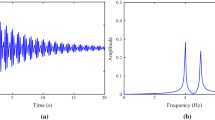Abstract
Hilbert vibration decomposition (HVD) is an effective tool for decomposing multi-component signals into several mono-component signals, while HVD may result in a poor decomposition when the energies of two or more modes are close. In this paper, a masking signal enhanced HVD is proposed and further utilized for modal parameters identifications of civil and mechanical systems. The enhanced HVD is used to decompose structural vibrational signals into mono-component modal responses. The empirical envelope method is then used to calculate the instantaneous frequencies and instantaneous dam** ratios of the modal responses. Several numerical and experimental examples are analyzed to demonstrate the superiority of the enhanced HVD relative to the original HVD and the well-known empirical mode decomposition, by which the accuracy of the modal parameter identification method is also validated. The enhanced HVD is proved to outperform the original HVD and the empirical mode decomposition in decomposing certain types of signals. The present modal parameter identification technique is efficient and accurate for typical linear and nonlinear structures, including systems with closely spaced modes, low energy modes, amplitude-dependent modal parameters, etc. Therefore, the present modal parameter identification technique can be a useful tool for the identification of large-scale civil structures, e.g., long-span bridges.











Similar content being viewed by others
Availability of data and materials
All figures are available from the corresponding author on request.
Code availability
All codes are available from the corresponding author on request.
References
Bedrosian E (1963) A product theorem for Hilbert transforms. Proc IEEE 51(5):868–869
Bendat, J.S., Piersol, A.G., Engineering applications of correlation and spectral analysis. New York, 1980.
Chen J, Xu YL, Zhang R (2004) Modal parameter identification of Tsing Ma suspension bridge under Typhoon Victor: EMD-HT method. J Wind Eng Ind Aerodyn 92(10):805–827
Feldman M (2006) Time-varying vibration decomposition and analysis based on the Hilbert transform. J Sound Vib 295(3–5):518–530
Feldman M (2011) Hilbert transform in vibration analysis. Mech Syst Signal Process 25(3):735–802
Gautier P-E, Gontier C, Smail M (1995) Robustness of an ARMA identification method for modal analysis of mechanical systems in the presence of noise. J Sound Vib 179(2):227–242
Ge X, Yura JA (2019) The strength of rotary-straightened steel columns. In: Proceedings-annual stability conference, SSRC, St. Louis, MO
He X, Hua X, Chen Z, Huang F (2011) EMD-based random decrement technique for modal parameter identification of an existing railway bridge. Eng Struct 33(4):1348–1356
Huang NE, Shen Z, Long SR, Wu MC, Shih HH, Zheng Q, Yen N-C, Tung CC, Liu HH (1971) The empirical mode decomposition and the Hilbert spectrum for nonlinear and non-stationary time series analysis. Proc R Soc Lond Ser A Math Phys Eng Sci 1998(454):903–995
Huang NE, Wu Z, Long SR, Arnold KC, Chen X, Blank K (2009) On instantaneous frequency. Adv Adapt Data Anal 1(02):177–229
Ibrahim S (1977) Random decrement technique for modal identification of structures. J Spacecr Rocket 14(11):696–700
Kijewski T, Kareem A (2003) Wavelet transforms for system identification in civil engineering. Comput Aid Civ Infrastruct Eng 18(5):339–355
Nuttall A, Bedrosian E (1966) On the quadrature approximation to the Hilbert transform of modulated signals. Proc IEEE 54(10):1458–1459
Ren W-X, Zong Z-H (2004) Output-only modal parameter identification of civil engineering structures. Struct Eng Mech 17(3–4):429–444
Rilling G, Flandrin P (2007) One or two frequencies? The empirical mode decomposition answers. IEEE Trans Signal Process 56(1):85–95
Song Y, Liu Z, Rønnquist A, Nåvik P, Liu Z (2020) Contact wire irregularity stochastics and effect on high-speed railway pantograph–catenary interactions. IEEE Trans Instrum Meas 69(10):8196–8206
Song Y, Wang Z, Liu Z, Wang R (2021) A spatial coupling model to study dynamic performance of pantograph-catenary with vehicle-track excitation. Mech Syst Signal Process 151:107336
Yan B, Miyamoto A (2006) A comparative study of modal parameter identification based on wavelet and Hilbert–Huang transforms. Comput Aid Civ Infrastruct Eng 21(1):9–23
Yan B, Miyamoto A, Brühwiler E (2006) Wavelet transform-based modal parameter identification considering uncertainty. J Sound Vib 291(1–2):285–301
Zhang M, Xu F (2019) Variational mode decomposition based modal parameter identification in civil engineering. Front Struct Civ Eng 13(5):1082–1094
Zhang Y, Zhang Z, Xu X, Hua H (2005) Modal parameter identification using response data only. J Sound Vib 282(1–2):367–380
Zhang M, Xu F, Ying X (2017) Experimental investigations on the nonlinear torsional flutter of a bridge deck. J Bridg Eng 22(8):04017048
Zhang M, Xu F, Øiseth O (2020b) Aerodynamic dam** models for vortex-induced vibration of a rectangular 4: 1 cylinder: comparison of modeling schemes. J Wind Eng Ind Aerodyn 205:104321
Zhang M, Xu F, Han Y (2020a) Assessment of wind-induced nonlinear post-critical performance of bridge decks. J Wind Eng Ind Aerodyn 203:104251
Zheng J-D, Cheng J-S, Yang Y (2012) A new instantaneous frequency estimation approach-empirical envelope method. J Vibr Shock 31(17):86–90
Funding
The authors appreciate the financial support from Changsha Planning & Design Survey Research Institute.
Author information
Authors and Affiliations
Contributions
C.L., Conceptualization, Methodology, Formal analysis and investigation, Writing—original draft preparation; Y.C., Conceptualization, Methodology, Writing—original draft preparation.
Corresponding author
Ethics declarations
Conflict of interest
The authors declare that they have no known competing financial interests or personal relationships that could have appeared to influence the work reported in this paper.
Rights and permissions
About this article
Cite this article
Li, C., Cao, Y. Modal Parameter Identification Based on an Enhanced Hilbert Vibration Decomposition. Iran J Sci Technol Trans Civ Eng 46, 1841–1852 (2022). https://doi.org/10.1007/s40996-021-00705-9
Received:
Accepted:
Published:
Issue Date:
DOI: https://doi.org/10.1007/s40996-021-00705-9




